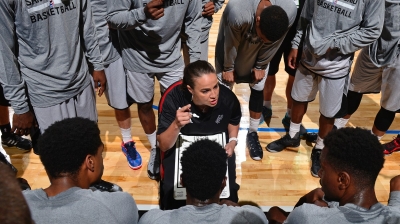4 Ways to Adapt Your Coaching Style to the Needs of Your People

No two people on your Sales team are the same. Coach accordingly…
You’ve been coaching one of your salespeople and you think you’ve made good, clear points. You explained what needs to come next. And you’ve discussed what they need in exactly the way you understand it. Yet they’re still not following through. They’re still not growing. They’re still not executing on the plans, and they’re still not getting the results you expected. It’s like they’re not hearing you during sales coaching sessions.
If you’re a sales manager and coach, then you probably know this feeling. I had a client tell me about a similar experience with a salesperson she was coaching who was right on the brink — either about to leave the organization or about to get fired. Despite all the effort she was putting into coaching them, they weren’t seeing results.
After some training, this sales manager had an epiphany. She realized she was coaching in the way she wanted to be coached. As a result, she utterly missed connecting with this sales rep in the most effective way. After she learned how to adapt to this person’s Behavior Style, she discovered that this person was not only worth saving, they had the potential to become a star performer. And with the right coaching, this person was now excelling.
Our recent research study underscored not only the important role coaching plays in boosting sales and productivity, but also the challenges many companies face in getting coaching right. This story adds another dimension to those numbers: Just think how many times someone didn’t make it in the business, not necessarily because of what they did or didn’t do, but because they weren’t coached properly.
In a previous post, we discussed some of the attributes of the four different Behavior Styles, particularly as they relate to sales coaching. In this post, we’re going to take a deeper dive into how you can use Behavior Styles as a foundation for your sales coaching efforts. For more tips and tools, be sure to check out our recent webinar with Training Industry.
Sales Coaching and Behavior Styles
When it comes to Behavior Styles, one of the first things you’ll notice is that most people aren’t just one style. More commonly, people will exhibit a combination of two or even three (and, rarely, all four) styles. But no style is better than the others. Style isn’t “good” or “bad”; it’s just different. Each has its strengths and weaknesses.
You’ll probably also quickly discover that there is a mix of styles within your organization. Participants in the recent webinar were fairly even distribution across all four styles. This is very common, and in fact, we need a mix of styles in our organizations. The challenge is recognizing how that influences the ways in which we coach. You can’t be all things to every person, but in one-on-one situations, you can adapt to another person’s styles, and in meetings, you can incorporate different styles. Effective sales coaches think about what their audience needs, not what they themselves would prefer.
Here are some strategies to help you apply Behavior Styles to your coaching efforts.
Understand your style, including strengths/weaknesses.
First, you have to understand yourself, and the best way to do this is to take our free Behavior Styles Assessment, which will provide a full picture of your own style and how it impacts the way you communicate.
Identify the other person’s style. Next, think about your people within the context of the four different Behavior Styles. What do you recognize clearly and quickly about them? Where do they gravitate, and what are they really good at? This will give you some clues about how they’re naturally wired. Also consider what characteristics you share — or don’t. Are there things they’re good at that you struggle with? Or that you think are super easy but they’re not doing? These might be indications that they’re an opposite style from you.
Adapt communication to their style.
The goal of the first two steps is to be able to figure out what you know about yourself and that person, and what those clues reveal about how you need to communicate. Keep in mind, it’s not just about tolerating their characteristics; it’s about planning ahead and taking active steps to make the coaching engagement effective for them.
Own the responsibility.
When we polled webinar participants about what style they find to be most challenging to coach, the majority said Controllers (45%), followed by Talkers (29%) — an interesting contrast, considering Controllers are typically very organized and detail-oriented while Talkers are generally the opposite. No matter what style you struggle with the most as a coach, it’s on you to make the coaching conversations productive.
Often, the most challenging person to coach is someone whose style is the opposite of yours. One client told us about his experience coaching a team of Supporters. Because Supporters are deliberate in their thinking, they can take some time to articulate a response. As a Doer, though, this client was uncomfortable with the long silences, so he tended to steamroll over them and fill in the blanks when they didn’t answer right away.
After he learned about the differences in their Behavior Styles, he changed his approach: He stopped and waited after asking questions…and was blown away by all the terrific answers they provided. He realized that by jumping in before they’d had the chance to respond, he’d lost out on a lot of valuable input over the years. But since Supporters aren’t confrontational, no one had ever said anything to him. It was up to him to figure this out.
Just having the same style, though, doesn’t necessarily make it easier. Two Talkers, for example, may have trouble staying organized and focused on the details. Two Doers might struggle if they both want to take charge. A sales coach who’s done the prep work will know what to look out for and how to plan to make sure things move forward.
That last point is key. As the coach, so much of the effectiveness and outcomes of your coaching efforts comes down to you. It relies on you being able to think ahead, understand your people, recognize their full potential (even if they don’t yet see it) and adapt to what they need. It’s not about trying to be someone else. It’s about trying to be your best self by communicating in a way that meets your team’s needs more effectively.

Executive Partner & Board Member
Related Blog Posts



